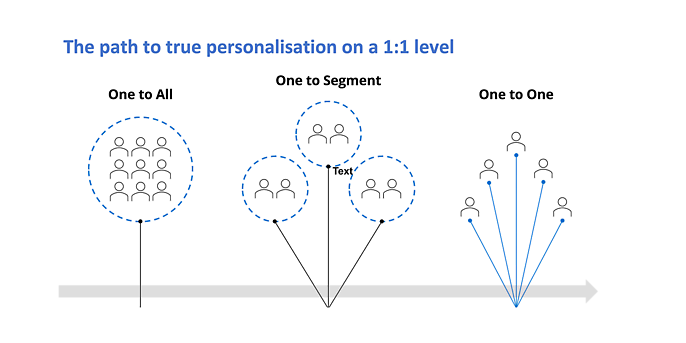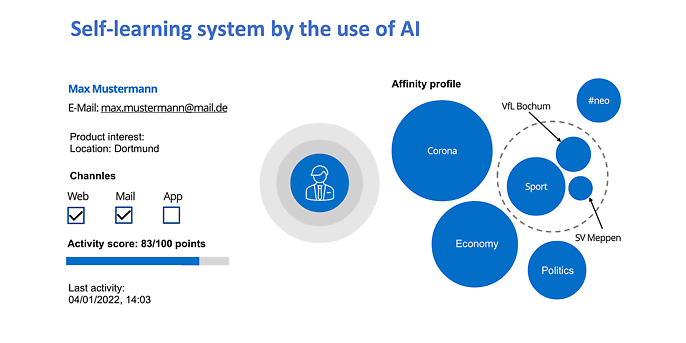17. March 2022 By Svenja Pschichholz
Unified customer profiles – why personalised communication is so important
A personalised approach influences customer loyalty
According to a study by performance management company Nielsen, 59 per cent of consumers prefer to buy new products from brands they’re familiar with. 21 per cent of respondents said that they bought a new product because it came from a brand they liked . This demonstrates why personalisation is such an important factor. Here’s an example to illustrate the point: a customer is subscribed to a company’s newsletter and can be identified as a known visitor. Their previous visits revealed that they seem to be interested in skipping ropes. This person can now be targeted with new offers that match their interests, such a fitness mat, for example. The product itself can be offered together with related products. This provides the person with relevant information, has a positive influence on their loyalty as a customer and increases the number of conversions.
Self-learning via AI
Artificial intelligence (AI) can be used to compile personal data and create personalised content. Going back to the use case involving fitness accessories that we mentioned earlier, in this situation AI helps to filter the right information, extrapolate what needs to be done and suggest personalised content to users. This does things such as increase the conversion rate, for instance. In addition to personalised product recommendations, individual website content (such as headlines) can be customised or personalised landing pages can be created.
If customers feel that a brand or a company understands their preferences and needs, then their loyalty to them can be strengthened, resulting in boosts in the conversion rate and sales. Consequently, every company should be able to identify their customers’ individual needs in order to be successful in the long term. But doing so isn’t that easy. Target group analyses have long been part of marketing strategies, but as the name suggests, the data from these analyses is recorded in groups. The problem is that customers are simply assigned characteristics and not regarded as individuals. Unified customer profiles extend beyond the limitations of the group and enable companies to collect and aggregate customer data across all touchpoints of the customer journey, allowing them to create so that a 360-degree view of the customer. This personalised approach enables one-to-one customer communication.

What data is available?
Companies need as much information as possible about the customers’ profiles if they are to create suitable content. The more information that is available, the better an AI learns and is able to better predict and implement automated personalisation measures accordingly. In the course of a session, a visitor comes into contact with various touchpoints on their customer journey and reveals a wealth of information about themselves. This data can be generated using information from personalised newsletters in e-mail marketing, information on app usage, inputs and interactions on the website or information on interactions with product recommendations – but only if it can also be tracked and recorded in the system, for example, in customer profiles.
Let’s take another look at the example of a customer who’s looking for new fitness accessories on the online store. We assume they were directed to the shop’s website by an advertisement. Various products are suggested that elicit a conscious or unconscious response. Products are rated based on whether they are saved in the shopping basket, marked as favourites or simply clicked away. Each click on a link or additional product collects information about the user’s interests:
- Which products and content are they viewing?
- Which touchpoints are customers using to come into contact with the website?
- Are they adding products to their shopping basket and buying them?
- Is it a new or existing customer?
- How much time are they spending on a website?
- When and why do people leave the website?
- Where is the visitor in the customer journey?
Developing the customer profile and enriching it with additional information
Various tools can be used to generate additional data. For example, a short survey can be sent to the person visiting the website in the course of the session in order to collect their consumer opinion. Participating in this type of survey doesn’t take up a lot of the customer’s time, but it is an important source of information for creating a UCP. Demographic information can be collected if customers register with a customer profile. This includes information on things such as age, gender or place of residence, as well as information about past transactions and consumer purchasing behaviour.
Interpreting the database
This information is collected and assessed via web tracking, direct communication with the customer or during the registration process. The generated data is filtered and summarised in a UCP. AI or logic-based rules segment this data based on past or current activities and assess and evaluate each customer individually. The UCP displays a real-time, 360-degree overview of all customer activity and includes elements such as personal information, activities (social media, for example), relevant KPIs (such as the conversion rate), product views or purchase behaviour. The information generated should be analysed and the KPIs reconciled so that what needs to be done can be extrapolated.

What are the benefits of a UCP?
UCPs are an important source of information for doing things such as preparing sales staff for customer meetings. Another point is that generating new leads involves higher costs and more effort than maintaining and strengthening existing customer relationships, which makes UCPs an important marketing tool. They help to produce personalised content that encourages customers to take a specific action, such as making a purchase or subscribing to the newsletter. Consequently, content that customers perceive as useful increases brand loyalty and the likelihood that the desired action will be taken.
Conclusion
Satisfied customers ensure a company’s success. Knowing who the customer is and what they want boosts the conversions it wants to have. Identifying the needs and interests of the target person is considered to be the most important success factor in one-to-one communication. The UCP forms the basis for creating dynamic personalised content and retaining customers in the long term. Even if AI-based information is available, results should be compared with the self-determined KPIs, evaluated and constantly optimised.
We at adesso possess this expertise and help our customers in expanding their infrastructure to make it possible to create UCPs and enable personalised one-to-one communication. Our vision for our customers is to optimise personalised experiences at every possible touchpoint along the customer journey – whether in B2C or B2B. We’re happy to advise and support you in the expansion your information architecture, the technical and operational development of relevant use cases and the measurement and optimisation of AI reports.
Why not check out some of our other interesting blog posts?
Here you can find the free whitepaper about strategies, methods and tools for guaranteeing successful lead management.
Whitepaper (available in German)
You can find more exciting post from the adesso world in our latest blog posts.

